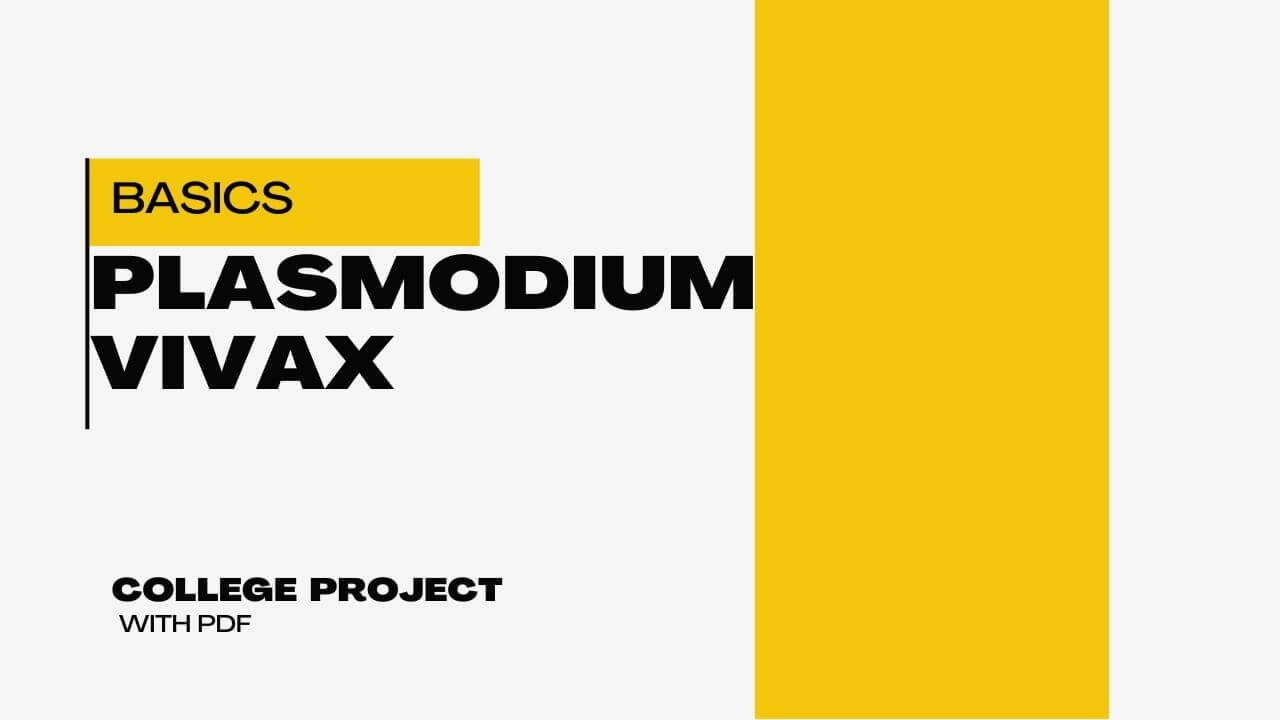Download your free Plasmodium vivax college project PDF here. We provide comprehensive research on the biology, structure, and lifecycle of Plasmodium vivax. Get the information you need to write a top-notch project
This Project prepare by a student: may be Some mistake in this project. we post this project without verify.
The Malarial parasite
- The most interesting sporozoan genus is plasmodium
- Because of their malaria causing abilities, these species commonly referred as malarial parasites
- All resides in the RBC
- Mosquitoes are the vectors
- 4 species are known to cause different types of malaria
- P. vivax, P. ovale, P. malariae and P. falciparium
- Geographically distributed in tropical and temperate countries
- P. vivax is most commonly distributed and prevails in the temperate regions of the world.
Life Cycle of P. vivax
- P. Vivax is the most common of the human infecting malaria fever parasites.
- Causes benign tertian or vivax malaria, characterized by a 48 h cycle b/w first fever and subsequent chills and fever.
- Hosts: diagenetic
a. Man:
asexual cycle in two phases
First in liver- liver schizogony
Second in RBC – erythrocytic schizogony and forms gametes
b. Mosquito:
Sexual cycle is completed in female anopheles
It involves gametogony and sporogony
Asexual cycle of P. vivax in man
[1]. Infection
- Anopheles bite resulting in the inoculation of thousands of sporozoites along with saliva into the persons body (victim)
[2]. Sporozoites
- Infective form of parasite
- Small, spindle shaped measuring about 11-12 µ in length and 0.5-1 µ in width
[3]. Liver Schizogony
- After 30m of infection, sporozoites invades hepatic tissues and multiply by schizogony in two phases (pre and exo-erythrocytic)
a). Pre-erythrocytic phase
- Sporozoite becomes cryptozoite in hepatic cells and becomes spherical and non-pigmented schizont.
- Undergo multiple fission (schizogony) and forms numeros uninucleate At the end of phase, hepatic cell bursts and cryptomerozoites are
b). Exo-erythrocytic phase
- Cryptomerozoites enter new liver cells and becomes metacryptozoites
- Undergo similar schizogony and produces metacryptomerozoites.
- At the end of phase, hepatic cell bursts and cryptomerozoites are liberated
- Micro metacryptomerozoites invades RBC and starts erythrocytic schizogony and includes following stages:
a). Tropozoite stage
- Inside RBC, micro metacryptomerozoites becomes rounded and modified into trophozoite.
b). Signet ring stage
- Trophozoite grows, develops vacuole and clinically referred as signet ring stage.
c). Amoeboid stage
- Meanwhile signet stage develops into active amoeboid trophozoite
- At this stage, samle red eosinophilic granules appear in the cytoplasm-schuffners granules
d). Schizont
- Amoeboid trophozoite after feeding becomes rounded, grows in size and becomes schizont
- It undergoes schizogony and forms merozoites
- One erythrocytic cycle takes 48h
[5]. Post-erythrocytic schizogony
• Sometimes merozoites reach the liver and undergoes schizogonic development in the liver cells -post-erythrocytic schizogony.
[6]. Formation of gametes
- Merozoites increases in size to become rounded gametocytes.
- Male – microgametocyte and female- magagametocyte
- Gametocytes donot devide but remain as intracellular parasite until they either die or ingested by vector
Sexual cycle of P. vivax in man
[1]Ingestion by mosquito
- Female anopheles gets the infection by sucking the blood of infected person
- RBC are digested and gametocytes are liberated and lodged into the cavity of the gut.
[2]. Gametogony
- Development of gametes (Haploids) from gametocyte-gametogony/ gametogenesis.
- Gamtes are of two types
a). Microgametes
- Male or microgamete undergoes exflagellation in the midgut of mosquito
- Each nucleus divides by mitosis and produce 6-8 haploid daughter and assemble at periphery
- Cytoplasm outgrows into long thin flagella like projection and later these projections break away as mature male gamete
b). Megagametes
- Female megagametocyte undergo some reorganisationa nd becomes a female gamete, which is ready for fertilization.
[3]. Fertilization
- Megagamete gives out a cytoplasmic projection-fertilization cone.
- Microgamete attached to this cone and transfer its nucleus to megagamete
- Fertilization or syngamy takes place forms
- Diploid zygote
[4]. Ookinete
- After sometime zygote becomes active and shows gliding k/as ookinete moment and is
- It measures about 15-22 micron in length and 3 micron in width.
- It attaches itself to peritrophic membrane of gut.
[5]. Encystment
- Ookinete penetrates through walls of midgut, becomes spherical and begins enyst.
- The encysted zygote – oocyst / sporont
[6]. Sporogony
- Oocyst enters into a phase of asexual multiplication- sporogony
- Firstly divides by meosis and then by mitosis and forms enormous haploid nuclei surrounded by cytoplasmic masses
- The daughter nuclei arrange themselves along the margin of cytoplasmic masses and later forms slender finger like processes having single nuclei in each
- In this way about 10,000 minute slender and sickle bodies are formed-sporozoites.
- When sporozoite matures oocyst ruptures and liberated into haeomocoel later penetrates into salivary glands
- Whole sexual cycle completes into 0-12 days
- Now mosquito becomes infective
Pathogenesis of malarial parasite
Symptoms of malaria first appear several dais after the infection of the parasite.
This time — incubation period Each attack of fever shows three stages:
1. Cold Stage
- At the onset of malaria patent suffers from severe shaking chill.
- Cold stage lasts for 20 min
2. Hot stage
- As the chill subsides, the body temp rises as high as 106°F. and lasts for 1-4 h.
3. Sweating stage
- As the temp lowers down, patent sweats profusely.
- Fever comes down and temperature becomes normal
- Malaria fever occurs when schizont in RBC bursts and set free their merozoites and malarial pigment haemozoin in the plasma.
Anemia is inevitable due to:
- Destruction of RBC
- Infected RBC become more fragile and rupture easily
- Parasite produce haemolysin- brings haemolysis
- In chronic case- spleen becomes enlarged
Control of Malaria
Control Measures falls into three categories:
- Elimination or destruction of vector
- Prophylaxis (prevention of infection)
- Treatment of infected patents
[A] Destruction of anopheles
Most effective and surest way of controlling malaria and can be done through
- Destruction of adult mosquitoes: method used are killing of hands, traps, fumigation, spraying and sterilization.
- Elimination of breeding places: swampy, marshy and water logging areas are cleared out, bushes and shrubs are cleared off etc.
- Destruction of larvae and pupae of mosquito through proper drainage (Flowing water), oil screens, chemical larvicides and biological methods.
[B]. Prevention of infection
- Through the use of insect repellent, nets, gloves and by screening bedroom windows.
[C]. Treatment
- Chlorquine and quinine: anti-erythrocytic stage drugs.
- Primaquine and pyrimethamine: anti-exoerythrocytic stage drugs
Plasmodium Vivax College Project Free PDF
| Odia Application to BDO | Click Here |
| Sarojini Naidu in Odia 1200 Word Free PDF | Click Here |






